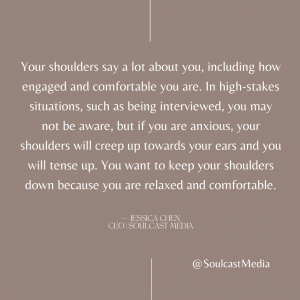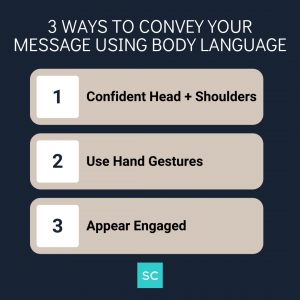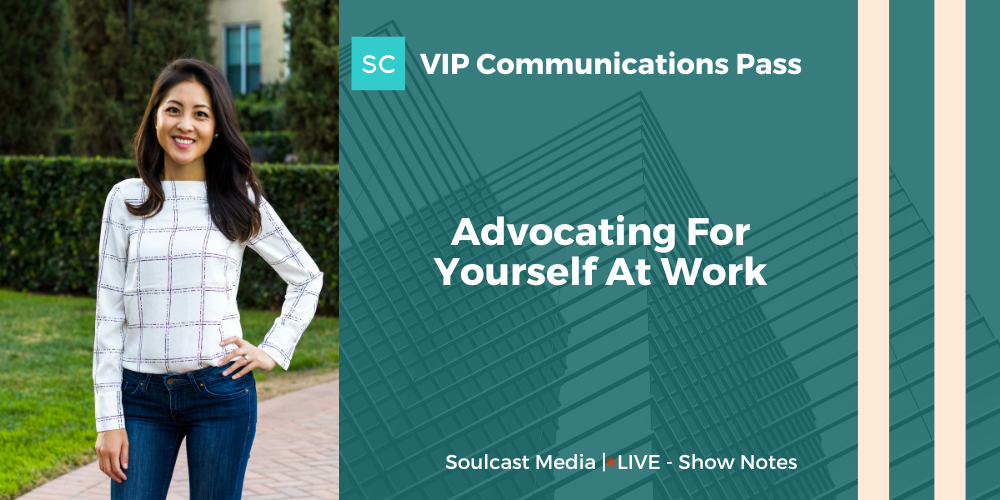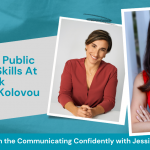How To Convey Your Message Using Body Language
In the communications world, we say your communications are made up of three elements: your choice of words, tone of voice, and body language. Of the three, researchers say, your body language makes the most significant impact on how people perceive your communications ability, specifically 55%. Your tone of voice makes up about 37%, and your choice of words is about 8%.
Because so much emphasis is on your body language, there are a few things you need to be mindful of, so you can give off the impression you want when you are speaking with those in the media.
Below are three strategies to help you convey your message using body language.
1. Head And Shoulders
The way you use your head and shoulders can help you convey your message effectively. They can also show confidence and engagement.
- Shoulders – Your shoulders say a lot about you, including how engaged and comfortable you are. In high-stakes situations, such as being interviewed, you may not be aware, but if you are anxious, your shoulders will creep up towards your ears, and you will tense up. You want to keep your shoulders down because you are relaxed and comfortable. Even if you aren’t feeling comfortable, take a second to breathe. Being mindful of your breath can help relax you and your shoulders.

- Head – When you are talking with the person, make sure you are nodding your head. This will show you are listening to what they are saying.
- Eyes – You want to make sure you maintain good eye contact with the person interviewing you. For example, if you are constantly shifting your eyes, you will seem uninterested or unsure of yourself. When you maintain good eye contact you will appear confident and engaged.
Being mindful of how your shoulders, head, and eyes will help you convey your message with positive body language.
2. Your Hands
Your hands can be a huge asset when used correctly. Often, people aren’t sure what to do with their hands, especially if they are being interviewed or presenting. Using your hands correctly can help show you are engaged, and emphasize important points of your message.
When using your hands, keep the following in mind:
- Show You Are Engaged – The message you deliver is exciting to you, and you can show your excitement by using gestures. For example, if you are in a zoom interview or meeting, be sure to take your hand off of the mouse and use your hands as you speak. If you are giving a presentation or being interviewed, be intentional with your gestures. For example, if you are telling a story and in the story, you say the word stop, you can raise your hand like you are actually telling someone to stop. Don’t leave your hands at your sides. This may come across as still and unengaged.

- Emphasize Points – You can use your hands to emphasize the points you want to make by pushing them forward. For example, if you have a point you want the audience to pay attention to, you can gesture with your hands. You can push your hands forward to show this is something to hear.
- Numericals – You can also use your hands to emphasize numericals. For example, if you say, there are two things I want to point out here. You can hold up two fingers to emphasize your point.
Your hand gestures should be intentional, well thought out, and engaging so that they can have maximum impact.
3. Appearing Engaged
You want to be mindful of appearing engaged. If you are giving a message and don’t appear engaged, your audience definitely won’t be.
There are two ways to make sure you appear engaged.
- Angle Your Body – This means angling your body towards the person you are speaking with. This applies to both sitting and standing interviews. For example, if you are being interviewed on camera, instead of facing the camera straight on, turn yourself slightly to face the person who is interviewing you.
- Lean In – Leaning in means slightly bending your head or waist towards the person you are speaking to. This subtle cue will show you are engaged and interested in what is being said.
Appearing engaged will help your audience understand the intent of your message.
Your body can really speak volumes about whether or not you are comfortable and confident in your message. When speaking with those in the media, you want to be mindful of what you are saying and how credible you are coming off through your body language.
__
Whenever you’re ready, there are 3 ways we can help you:
- Discover your communications style so you know where to start. Over 4,000 people have found theirs here.
- Attend our monthly communication workshop to build communications confidence (new topics: public speaking, advocating for yourself, building credibility, etc) here.
- Get your brand in front of 43k+ people by sponsoring our newsletter or Soulcast Media | LIVE LinkedIn events [contact: hello@soulcastmedia.com]











